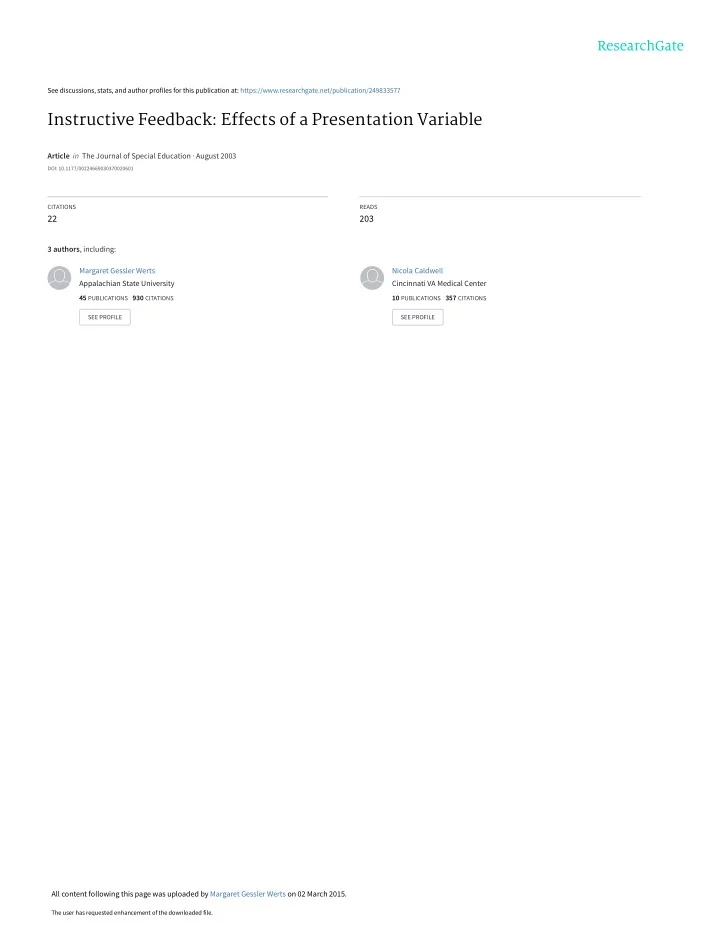

See discussions, stats, and author profiles for this publication at: https://www.researchgate.net/publication/249833577 Instructive Feedback: Effects of a Presentation Variable Article in The Journal of Special Education · August 2003 DOI: 10.1177/00224669030370020601 CITATIONS READS 22 203 3 authors , including: Margaret Gessler Werts Nicola Caldwell Appalachian State University Cincinnati VA Medical Center 45 PUBLICATIONS 930 CITATIONS 10 PUBLICATIONS 357 CITATIONS SEE PROFILE SEE PROFILE All content following this page was uploaded by Margaret Gessler Werts on 02 March 2015. The user has requested enhancement of the downloaded file.
124 THE JOURNAL OF SPECIAL EDUCATION VOL. 37/NO. 2/2003/PP. 124–133 Instructive Feedback: Effects of a Presentation Variable Margaret Gessler Werts, Appalachian State University Nicola K. Caldwell, University of Pittsburgh Mark Wolery, Vanderbilt University Instructive feedback involves presenting extra nontarget stimuli in the consequent events of instruc- tional trials and not requesting students to respond to those stimuli during instruction. The purposes of this study were to evaluate whether students (a) would acquire the behaviors for instructive feedback stimuli when those stimuli were presented after trials on any of a set of target behaviors rather than after a given target behavior and (b) acquired instructive feedback behaviors during acquisition of tar- get behaviors or after mastery of those target behaviors. Four 11-year-old boys with mild disabilities participated, instruction occurred in their special education classroom, and a multiple-probe design across sets of behavior was used. Results indicate that the students (a) acquired their target behaviors, (b) acquired a high percentage of the behaviors for instructive feedback stimuli, and (c) generally ac- quired instructive feedback responses while acquiring target behaviors. The findings are discussed in terms of future research on instructive feedback and implications for practice. Instructive feedback is a modification of systematic instruc- of the target behavior. An association thus is possible between tion to allow students to learn extra behaviors (Werts, Wolery, the target stimuli/behaviors and instructive feedback stimuli/ Holcombe, & Gast, 1995). Instructive feedback involves add- behaviors. Subsequently, continuous and intermittent sched- ing extra nontarget stimuli to the consequent events of trials ules for delivering instructive feedback were compared, and on target behaviors. During instruction, the teacher presents both produced similar learning (Griffen, Schuster, & Morse, the target stimulus, provides an interval for a student response, 1998). delivers the consequences, and presents an additional stimu- Another question that came up is the following: When lus (instructive feedback stimulus). Students are not asked to during instruction do students acquire instructive feedback re- respond to the additional stimulus and are not reinforced if sponses? Performance on instructive feedback stimuli has they do. Students—from preschoolers to adolescents—with a been measured before instruction and after criterion on target wide range of disabilities and levels of severity have acquired behaviors (on a pre- and posttest basis). One study (Anthony, a majority of the behaviors for the instructive feedback stim- Wolery, Werts, Caldwell, & Snyder, 1996) compared the pre- uli (Werts et al., 1995). This finding occurred in one-on-one and posttest measurements to daily probe sessions of the in- and small-group instruction and when trials were embedded structive feedback. Students acquired responses with both in independent seatwork (Caldwell, Wolery, Werts, & Cald- measurement systems, and the daily probes indicated that they well, 1996). It has occurred when delivered by researchers and acquired instructive feedback responses while learning target teachers and even by peers (Collins, Branson, & Hall, 1995). behaviors rather than after initial mastery. However, the daily Instructive feedback thus results in additional learning and is probing may have produced learning by functioning as a de- a desirable addition to direct instruction. mand situation (i.e., learn what the teacher tests daily). Despite replication, the mechanisms causing students to The current study was done to extend the earlier work learn instructive feedback behaviors are not clear (Wolery, in two ways. First, instructive feedback stimuli were presented Werts, & Holcombe, 1993). Possible explanations include in- after any target behavior in a set being taught rather than after cidental and/or observational learning. Another explanation is a given target behavior. This allowed us to test whether as- that a relationship emerges between the target behaviors and signing instructive feedback stimuli to given target behaviors the corresponding instructive feedback. This explanation is a is necessary for learning instructive feedback responses. Sec- possibility because in all studies reviewed by Werts et al. ond, the students’ performance on instructive feedback stim- (1995), each instructive feedback stimulus was (a) assigned to uli was assessed after the first session in which they achieved a given target stimulus/behavior and (b) presented on each trial 100% correct responding on target behaviors rather than after Address: Mark Wolery, Department of Special Education, Box 328, Peabody College, Vanderbilt University, Nashville, TN 37203; e-mail: mark.wolery@vanderbilt.edu
Recommend
More recommend